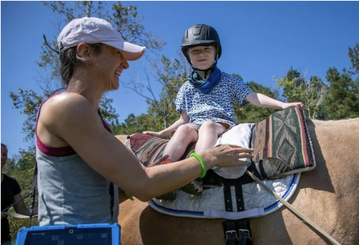|
By: Melinda Li Edited by: Sophia Collis When hearing about hippotherapy for the first time, most are confused as the image of a semiaquatic, large-tusked animal pops into mind. In actuality, the term stems from the Greek word “hippos” meaning “horse,” and falls under a broader category of horse-assisted therapy. Through this unconventional treatment method, patients interact with horses to promote physical and mental health. Five-year-old George Palmer is one of the many patients who has benefited from hippotherapy. Diagnosed with autism at age three, George is working on improving his balance, motor, and communication skills through horseback riding sessions. His father David says that George has become more vocal over the past six months of training, and remarks that: “It’s pretty wonderful just to see him enjoying himself, developing and growing” (1). In a typical hippotherapy session, the patient rides horseback alongside a team of instructors, a therapist, and a horse trainer. When walking, the horse’s pelvis has a 3-axial movement pattern just as humans do, and this rhythmic pattern provides sensory feedback to the patient’s brain (2). During a typical 15-20 minute session, this translates to 1,500-2,000 neuromotor inputs to the patient (3). Research has shown that this neural activation encourages posture and fine motor control, balance, core body connection, as well as improving speech, cognition, and language (2). The applications of hippotherapy extend far beyond autism to a broad range of physical and mental disabilities. A study conducted by Vermöhlen et al. in 2017 saw significant improvements in balance, fatigue, spasticity, and quality of life in multiple sclerosis patients (4), while a 2016 study by Hsieh et al. showed major enhancements in mobility of joint functions and muscle tone functions in child patients with cerebral palsy (5). Other applications of hippotherapy include the treatment of patients with, anxiety, post-traumatic stress disorder, and those who have suffered from a stroke. There is still a lot to learn about the effectiveness and mechanisms of hippotherapy. Even so, the treatment has gained significant attention and validation by members of the healthcare community, who are excited by its promise for the future of physical and occupational therapy.  5-year-old George Palmer receives hippotherapy horseback riding sessions at Myrtle Beach Therapeutic Riding and Vaulting Club in Loris, South Carolina. (Image by Jason Lee for Myrtle Beach Sun News) Citations:
[1] Strong, Hannah. “'It's Pretty Wonderful': How Riding Horses Is Helping Kids with Special Needs in Loris.” Myrtle Beach Online. Myrtle Beach Sun News, September 25, 2019. http://www.myrtlebeachonline.com/news/local/article235182512.html. [2] Koca, Tuba Tulay. “What Is Hippotherapy? The Indications and Effectiveness of Hippotherapy.” Northern Clinics of Istanbul, January 15, 2016. https://doi.org/10.14744/nci.2016.71601. [3] “What Is Hippotherapy?: American Hippotherapy Association.” American Hippotherapy Association Rebuild. Accessed October 4, 2019. https://americanhippotherapyassociation.org/what-is-hippotherapy/. [4] Vermöhlen, Vanessa, Petra Schiller, Sabine Schickendantz, Marion Drache, Sabine Hussack, Andreas Gerber-Grote, and Dieter Pöhlau. “Hippotherapy for Patients with Multiple Sclerosis: A Multicenter Randomized Controlled Trial (MS-HIPPO).” Multiple Sclerosis Journal 24, no. 10 (March 2017): 1375–82. https://doi.org/10.1177/1352458517721354. [5] Hsieh, Yueh-Ling, Chen-Chia Yang, Shih-Heng Sun, Shu-Ya Chan, Tze-Hsuan Wang, and Hong-Ji Luo. “Effects of Hippotherapy on Body Functions, Activities and Participation in Children with Cerebral Palsy Based on ICF-CY Assessments.” Disability and Rehabilitation 39, no. 17 (2016): 1703–13. https://doi.org/10.1080/09638288.2016.1207108.
0 Comments
Leave a Reply. |
